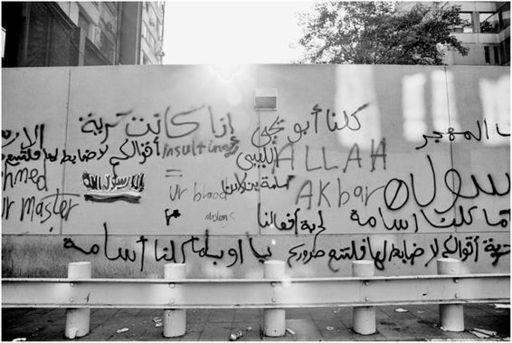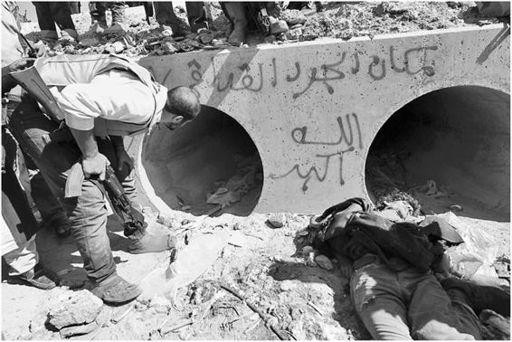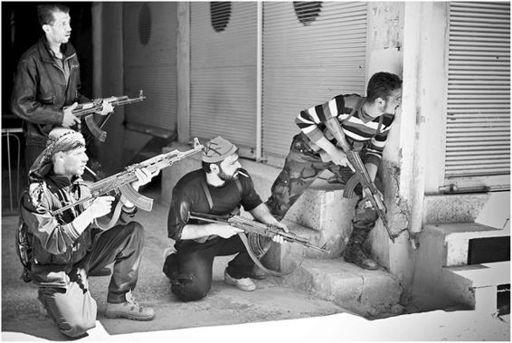The Modern Middle East (56 page)
Read The Modern Middle East Online
Authors: Mehran Kamrava
Tags: #Politics & Social Sciences, #Politics & Government, #International & World Politics, #Middle Eastern, #Religion & Spirituality, #History, #Middle East, #General, #Political Science, #Religion, #Islam

Figure 23.
Mohamed Morsi campaigning for the Egyptian presidency. Getty Images.

Figure 24.
The outer wall of the U.S. embassy in Egypt covered in graffiti, September 2012. Getty Images.
Whereas in Tunisia and Egypt revolutions succeeded relatively quickly and involved comparatively low levels of violence and bloodshed, revolutionary movements in Libya, Yemen, and Syria resulted in protracted and bloody civil wars. In each of these three cases, two critical variables resulted in fundamentally different revolutionary processes and outcomes. First, in Egypt and Tunisia the armed forces had been increasingly professionalized over the preceding decades and had developed a professional esprit de corps largely independent of political leaders. But a similar development had not occurred in countries such as Libya, Syria, and Yemen, where political leaders and their immediate family members, often sons and brothers, continued to retain control over key units within the armed forces. In these cases, unlike in Tunisia and Egypt, the interests of many of the most powerful sections of the military rested in ensuring the continued hold on power of the incumbents rather than siding with the protesters. Second, again unlike Tunisia and
Egypt, where there were few social divisions along religious, ethnic, or sectarian lines, Libya, Syria, and Yemen all featured rich mosaics of tribal and sectarian differences. State elites increasingly manipulated and magnified these differences as their hold on power became tenuous. This was also the case in Bahrain, where, backed by troops from Saudi Arabia, in February 2011 government forces crushed the peaceful protesters who had gathered in Manama’s central Pearl Square, suppressing the antiauthoritarian movement on the grounds that it was part of an Iranian-sponsored Shiʿite conspiracy.

Figure 25.
The sewer pipe where Muammar Qaddafi was captured, with a dead loyalist gunman in the foreground, October 20, 2011. Getty Images.
In Libya, anti-Qaddafi protests began in mid-February 2011, and within a few days Qaddafi lost control over Benghazi, the country’s second-largest city. As protests spread to Tripoli, fierce battles broke out between government forces and militias with support from mostly eastern parts of the country. In March, following a UN Security Council resolution authorizing a “no-fly zone” over Libya, NATO forces started providing air cover to the Libyan revolutionaries as the country descended into civil war. Tripoli finally fell in August, bringing Colonel Qaddafi’s reign to an end after forty-two years. But Qaddafi and a small band of dedicated followers continued to fight. He was eventually captured on October 20, 2011, when he was found hiding in a sewer pipe near the city of Sirte. He was dragged out, beaten, and shot dead.
Yemen’s transition was equally prolonged and contentious, starting in earnest in January 2011 in the form of mass protests against the rule of President Ali Abdullah Saleh, who had first ascended to the presidency of North Yemen in 1978 and had remained in office when North and South Yemen unified in 1990. Over the years Saleh had proven himself to be particularly adept at manipulating Yemen’s fractured tribal society to maximize his own powers, and those skills were especially helpful as brewing protests started to threaten his tenure in office. He repeatedly organized counterprotests in his own support and even survived a bomb blast in the presidential palace in June 2011. Eventually, however, he simply could not stem the tide of protests from a broad network of alliances that included the various opposition parties, the Houthis in the north, civil society organizations, and several tribes.
123
He finally left office in February 2012 and handed over formal power to his vice president, Abd Rabbuh Mansur Hadi.
In Syria, the increasing sectarianization of the uprising explains why the rebellion did not assume a mass basis and why most Syrians chose to stay home instead of actively fighting against the regime’s military forces. Major protests originally broke out across the country in mid-March 2011 following a localized protest in the city of Deraa earlier in the month. But the state’s response was fast and furious, unleashing violent repression on protesters who were initially mostly unarmed. Soon, however, as the protests continued and gained in intensity and violence, small arms began to be shipped to Syrian activists, who were increasingly organizing themselves into militia groups. The arms were supplied to the anti-Assad forces mostly by Qatar, which had earlier provided similarly critical arms to anti-Qaddafi fighters in Libya. Thus ensued one of the most violent and bloody civil wars in the recent history of the Middle East. According to news reports, from the start of the conflict to the end of 2012, somewhere between twenty thousand and forty-five thousand Syrians lost their lives in the conflict, and another five hundred thousand became refugees in neighboring countries.
124
Despite the global resurgence of democracy in recent decades and the spread of the “third wave” of democratization across South America and eastern Europe in the 1980s, authoritarianism showed remarkable resilience and staying power in the Middle East until the end of the first decade of the twenty-first century. Several factors underlay this resilience, chiefly the weakness of civil society, the continued strength of state institutions, and the societal relevance of state institutions as guaranteed through ruling
bargains that rested on nationalism, patrimonialism, and corporatism. Equally important was the absence of international pressures for democratization, which were of paramount significance in influencing the demise of authoritarian polities in eastern Europe and South America. In the Middle East, only Turkey let international forces directly shape its domestic priorities. As a result, the desire to be considered European and be admitted into the European Union prompted state elites to consistently maintain an imperfect but functioning democratic system beginning in 1983. No state, of course, is completely immune from the unfolding of international events and their potential consequences for domestic politics. Nevertheless, a vast majority of Middle Eastern states did not confront international developments that would have had domestic consequences for democratization. Ironically, the United States’ invasion of Iraq and its subsequent overthrow of the Iraqi state in 2003 strengthened authoritarian hard-liners throughout the Middle East. Up until the first decade of the new millennium, it seemed that the authoritarian states of the region were immovable fixtures of Middle Eastern politics.

Figure 26.
Syrian rebels engaging government forces near Saraquib City in April 2012. Getty Images.
But not quite.
The Arab Spring was a result of the unraveling of the dominant ruling bargain that had emerged across the Middle East beginning in the 1950s.
This ruling bargain is now being actively replaced by a new one that is redefining the sources of authority and legitimacy through a variety of devices (such as constitutions), experiences and processes (mass protests, civil wars, and elections), redefinition of the roles, functions, and at times structures of institutions (political parties and organizations, the armed forces, the executive), and personalities and personal actions and initiatives (agency). Across the Arab world and the Middle East, conceptions of “authority” and “political legitimacy” are being redefined and rearticulated. The ultimate questions concern the new shape, voracity, and staying power of these new, emerging conceptions of authority.
The scholar Marc Lynch warns that the lessons of the past are not that encouraging, that every episode of mass mobilization and public euphoria meant to usher in a democratic era in the Middle East has brought with it a “reconsolidation of state authority, sometimes under new leaders and sometimes under surviving regimes.” A “more repressive, stifling regional order” arising from a “deeper entrenchment of authoritarian regimes” may well be in the offing as a result of the 2011 uprisings.
125
Lynch’s sobering warning should not be lightly dismissed. So long as the post–Arab Spring regimes of the Middle East do not deliver on the promises that brought them to power, there is no reason to believe that their source of legitimacy will be any different from that of the regimes they replaced. By one estimate, for example, by 2020, some fifty million jobs are needed in the Arab world to absorb the new entrants into the job market. Today, some 40 percent of new entrants into the job market in the Arab world cannot find jobs.
126
Whether and how fast the region’s economy can provide employment opportunities to the youth, and what political consequences this is likely to have, remain open and troubling questions.
The question of democracy’s future in the Middle East remains equally difficult to answer. The antiauthoritarian movements that brought about the Arab Spring were hopeful starts. As history has demonstrated, more often than not the spread of democracy is a regionwide phenomenon, frequently engulfing nondemocratic neighbors in relatively rapid succession. Whether a regional role model will emerge out of the Arab Spring remains to be seen, as does its potential for triggering similar processes elsewhere. But if one of the Middle East’s authoritarian states were to become meaningfully democratic, it would be much harder for the remaining holdouts to keep democracy at bay.
9
The Palestinian-Israeli Conflict
One of the most vexing problems in the political history of the modern Middle East, and indeed of the larger global community, has been the conflict between Israelis and Palestinians. Through the vicissitudes of history and the vagaries of power politics, both international and domestic, these two peoples have come to inhabit the same piece of territory. We have, essentially, as the late Deborah Gerner put it, “one land, two peoples.”
1
Over the years, they have fought, cajoled, killed, and harassed each other. And they have been unwilling or unable to find ways of “sharing the promised land.”
2
An overwhelming majority of peoples on both sides have come to view the other as “the enemy,” dehumanized and devoid of rights or legitimacy. In defending a cause they view as singularly righteous and just, each side has inflicted pain and misery on the other. Today, neither side has a monopoly over fear of violence from the other.
History has been kind to neither the Zionists nor the Palestinians. Both communities have been scattered throughout the world at different times and forced to live in exile. In the diaspora, the Jews faced persecution and the threat of annihilation. The Palestinians, many of whom still live outside Palestine, are frequently used by Middle Eastern despots who claim the cause of Palestinian liberation for their own narrow, domestic political purposes. Since 1948, when the state of Israel was created and geographic Palestine ceased to exist, Israel has had the upper hand politically and militarily. Successive Israeli governments have deepened their dominance over former Palestine with every war they have fought, every policy initiative they have enacted, every new house or road they have built and every old one they have demolished, and every “settler” they have geographically placed in the land of Eretz Israel. But as chapter 3 demonstrated, the death and dismemberment of geographic Palestine have not destroyed the
identity of the Palestinians. Rather, these events have continued to shape not only their identity—or, rather, evolving identities—but also their attachment to Palestine and their sense of nationalism. Zionist territorial and military conquest of Palestine is now more than a century old. It started with the first
aliya
in 1881, achieved spectacular successes in the wars of 1948, 1967, and 1973, and continues to this day through the construction of settlement colonies in the remaining areas with large Palestinian populations. However, seldom in history have military conquests led to the total annihilation of indigenous identities. For the Palestinians, their sense of identity continues to define and distinguish them from those they consider to be occupiers and colonizers. Battles may have been won and lost, but the conflict continues.
